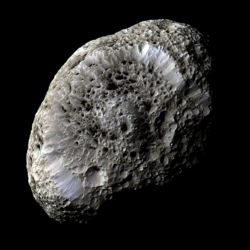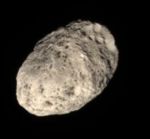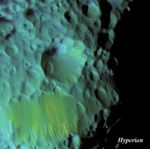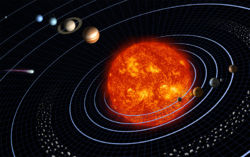Hyperion (Moon)
 From Conservapedia
From Conservapedia | Hyperion (moon) | |
|---|---|
 False-color image of Hyperion's sponge-like surface, taken by spacecraft Cassini | |
| Date of discovery | September 16, 1848[1] |
| Name of discoverer | William Cranch Bond[2] |
| Name origin | Member of the Titans, per an earlier suggestion by Sir John Herschel as reported by William Lassell[1][3] |
| Orbital characteristics | |
| Primary | Saturn |
| Order from primary | 21 |
| Perikrone | 1,326,769 km[4] |
| Apokrone | 1,635,431 km[4] |
| Semi-major axis | 1,481,100 km[5] |
| Orbital eccentricity | 0.1042[5] |
| Sidereal month | 21.276609 da[5] |
| Avg. orbital speed | 5.07 km/s[6] |
| Inclination | 0.43°[5] to Saturn's equator |
| Physical characteristics | |
| Mass | 5.5 * 1018 kg[5] |
| Density | 570 kg/m³[5] |
| Mean radius | 133 km[7] |
| Escape speed | 0.107 km/s[6] |
| Composition | Water ice and little rock[8] |
| Color | reddish rose tan |
| Albedo | 0.3[5][6][8] |
Contents
- 1 Discovery and naming
- 2 Orbital characteristics
- 3 Rotational characteristics
- 4 Physical characteristics
- 4.1 Surface
- 5 Observation and Exploration
- 6 References
Discovery and naming[edit]
William Cranch Bond and George Phillips Bond first noticed Hyperion as a faint object in Saturn's ring plane, between the moons Titan and Iapetus. In the course of several days, the Bonds saw this object again, and it was clearly keeping station with Saturn at the time of Saturn's apparent retrograde motion. They determined its sidereal month with remarkable accuracy and reported their findings in the Monthly Notices.[1]
Independently of them, William Lassell first observed Hyperion on September 18, 1848. He was searching for Iapetus and found two objects, Iapetus and another, much fainter object. The next day, the faint object had appeared to approach Saturn, while the other object had not. Lassell was satisfied that the brighter object was Iapetus and determined that he had discovered a new object.[9]
Sir John Herschel had earlier suggested a naming convention for the seven satellites of Saturn already discovered. Lassell and the Bonds independently selected Hyperion as the name of the new object, in accordance with that convention.
Orbital characteristics[edit]

Rotational characteristics[edit]
Hyperion's rotation is chaotic and nearly unpredictable.[11] Astronomers cite a number of factors, including the 4:3 orbital resonance with Titan, to account for this.[8][12][13]
Physical characteristics[edit]
Hyperion has an irregular shape, with dimensions 185 x 140 x 113 km.[5] In fact it is the largest irregularly shaped body in the solar system. Proteus, moon of Neptune, is often cited as a larger irregular body, but in fact Proteus is not irregular and is almost spherical.[12] Hyperion is also highly porous, with a density only 57% of that of water.[5]
Surface[edit]

Hyperion is one of the least reflective of Saturn's moons, with an albedo of 30%. Many astronomers believe that Hyperion is covered with dark material that comes from Phoebe, an outer moon.[6] Recent data from the Cassini probe indicates that this material consists of hydrocarbons.[15]
The favorite theory of the origin of Hyperion is that it is a fragment of a larger body that suffered a collision.[12][13] At least one astronomer speculated that debris from this collision contributed to the dark material that covers the Cassini Region of Iapetus.[16]
Observation and Exploration[edit]
Hyperion was under observation for centuries, but only with modern rocket probes has detailed examination been possible. The first such probe to make rendezvous with Hyperion was Voyager 2, on August 24, 1981. The best examination of Hyperion to date was by the Cassini spacecraft, which made rendezvous with Hyperion on September 26, 2005 and took the remarkable images of its spongiform surface.
References[edit]
- ↑ 1.0 1.1 1.2 Bond, W. C. "Discovery of a new Satellite of Saturn." Monthly Notices of the Royal Astronomical Society, 9:1, November 10, 1848. Accessed June 9, 2008.
- ↑ "Gazetteer of Planetary Nomenclature: Planetary Body Names and Discoverers." US Geological Survey, Jennifer Blue, ed. March 31, 2008. Accessed May 9, 2008.
- ↑ Lassell, William. "Satellites of Saturn." Monthly Notices of the Royal Astronomical Society, 8:42-43, 1848. Accessed June 9, 2008.
- ↑ 4.0 4.1 Calculated
- ↑ 5.0 5.1 5.2 5.3 5.4 5.5 5.6 5.7 5.8 Williams, David R. "Saturnian Satellite Fact Sheet." National Space Science Data Center, NASA, November 23, 2007. Accessed June 4, 2008.
- ↑ 6.0 6.1 6.2 6.3 Hamilton, Calvin J. "Entry for Hyperion." Views of the Solar System, 2001. Accessed June 9, 2008.
- ↑ "Planetary Satellite Physical Parameters." JPL, NASA. Retrieved June 9, 2008.
- ↑ 8.0 8.1 8.2 8.3 8.4 "Hyperion." Encyclopædia Britannica. 2008. Encyclopædia Britannica Online. 9 June 2008.
- ↑ Lassell, William. "Discovery of a new Satellite of Saturn." Monthly Notices of the Royal Astronomical Society, 8(9):195, November 1848. Accessed June 9, 2008.
- ↑ "Hyperion, Chaotic Moon." The Planetary Society. Accessed June 9, 2008.
- ↑ J. Wisdom, S.J. Peale, F. Mignard. "The chaotic rotation of Hyperion". (IAU, COSPAR, NASA, et al., Colloquium on Natural Satellites, 77th, Cornell University, Ithaca, NY, July 5–9, 1983) Icarus (ISSN 0019-1035) 58: 137-152. doi:0.1016/0019-1035(84)90032-0 Accessed June 9, 2008.
- ↑ 12.0 12.1 12.2 Arnett, Bill. "Entry for Hyperion." The
Nine8 Planets, July 12, 2007. Accessed June 9, 2008. - ↑ 13.0 13.1 13.2 Piazza, Eric. "Cassini-Huygens: Moons: Hyperion." November 3, 2006. Accessed June 9, 2008.
- ↑ Thomas, P. C.; et al. (2007). "Hyperion's sponge-like appearance". Nature 448: 50-56. doi:10.1038/nature05779. Accessed June 9, 2008.
- ↑ NASA/Ames Research Center. "Hydrocarbons, Necessary For Life, Found On Saturn's Moon Hyperion." ScienceDaily 6 July 2007. Accessed 9 June 2008.
- ↑ Matthews, Robert A. J. "The Darkening of Iapetus and the Origin of Hyperion." Quarterly Journal of the Royal Astronomical Society, 33:253–258, September 1992. Accessed June 9, 2008.
| |||||||||||||||||||||||||||||
Categories: [Astronomy]
↧ Download as ZWI file | Last modified: 02/23/2023 09:14:34 | 9 views
☰ Source: https://www.conservapedia.com/Hyperion_(moon) | License: CC BY-SA 3.0
 ZWI signed:
ZWI signed:
 KSF
KSF